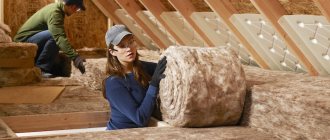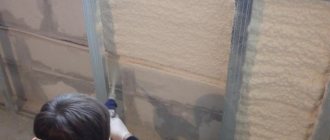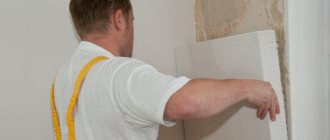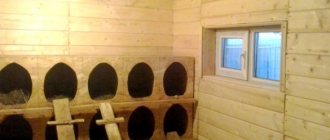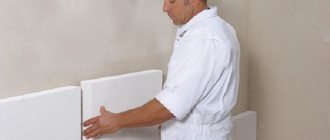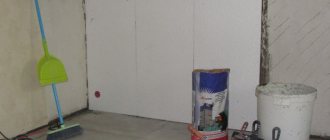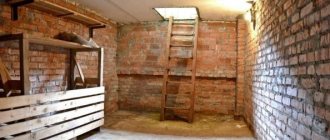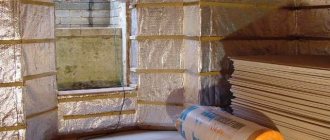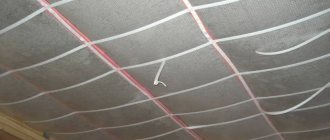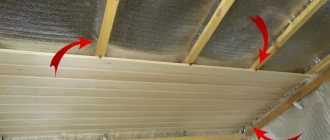Insulating the basement with high-quality thermal insulation will allow you to create a cozy underground room for household needs (workshop, storage of garden tools, installation of a boiler room, water filtration system, etc.), or for leisure (billiards room, sauna, home gym, etc.) .
Insulating the basement with high-quality PENOPLEX® slabs, which have a very low thermal conductivity coefficient (0.034 W/m∙K), will not only reduce heat loss through the basement, but will also prevent the development of fungus and mold. The biostability and unchanged properties of the material are due to its zero water absorption, i.e. your basement will retain its heat-insulating properties throughout its entire service life.
Is it worth insulating the basement?
The coldest and dampest part of a house or cottage is the cellar, through which up to 20% of the heat can escape, which could additionally be used to heat the living rooms. This requires spending more energy by the same percentage, which is not economically viable.
Insulating the cellar is also worth doing to protect the walls and foundation from constant getting wet. This is due to the constant change in temperature outside, which causes condensation to appear, settling on the walls of a poorly insulated room and ceiling located between the basement and the first floor (read also Condensation in the cellar: how to get rid of it).
High-quality insulation of the basement from the outside allows you to:
- Keep things intact.
- Protect the structures themselves from destruction; they will acquire an unpleasant odor and all kinds of microorganisms will begin to actively develop, which will ultimately lead to damage to the elements.
- Insulation should be used due to the direct contact of the first floor and the cellar. With any heating of the entire house, cold and dankness comes from below, and walking on the bare floor is not very pleasant and can lead to illness.
- Thermal energy that could be used to heat residential premises will be spent on heating an uninsulated basement, which increases the consumption of gas, electricity and other coolants.
The classic scheme for building a basement is shown in the photo.
Optimal basement insulation scheme
There are several ways to insulate a basement:
- Only from the outside, which prevents freezing of the walls of the structure.
- Only from the inside. In this case, condensation may form at the junctions of the walls and insulation, which will ruin the entire coating.
- Combine the first two methods. This is the most reliable way to insulate cellars.
Tip: When insulating a basement with your own hands, it is better to perform an insulation complex. In this case, insulation should be installed on the floors, walls and ceiling of the basement. This, even in an unheated cellar, will help create a temperature ranging from +5 to +10 degrees, which is quite enough for such a room.
The process of laying foam plastic indoors
Insulation procedures are often carried out after the construction of the structure. Therefore, insulation from the outside is problematic due to increased budget costs and time. The best option is to insulate from the inside.
- Use sheets with maximum thickness. For example, when calculating 200 mm of foam, it is necessary to purchase not four 50 mm tiles, but 2 100 mm each. This will reduce the number of seams. Accordingly, the surface will be insulated from moisture and freezing.
- Installation of expanded polystyrene is carried out at intervals at the seams and is at least 100 mm. The shift is carried out both vertically and horizontally. Multilayer installation involves overlapping the seams with a subsequent layer.
- Preparing the surface for insulation is a mandatory procedure. For this purpose, antiseptics and primers are used. After 100% drying of the products, waterproofing work is carried out. The materials must be continuous and laid tightly to the surface.
- The foam boards should be installed against the frame. Frame slats are mounted with a pitch equivalent to the finishing panels. Two sheets are installed on one rail.
- The joints of the sheets and the junction points with the frame are sealed with foam for installation. This is an additional waterproofing measure.
When calculating the thermal indicators of the thickness of the material, the dew point should not be recessed into the body of the wall. Due to this, condensation will not form, which means that the insulation will not be destroyed.
What are the features when insulating basements?
To insulate a cellar, careful waterproofing of the entire wall surface is necessary. In this case, it is better to carry out the work simultaneously when installing waterproofing and installing a drainage system. Various materials are used for insulation.
They must meet the following requirements:
- Possess good resistance to moisture, maintaining unchanged properties even in the most unfavorable conditions.
- Have the ability to withstand the occurrence of compression and pressure due to the thickness of soil masses.
- Characterized by sufficient strength and durability.
They may be:
- Extruded polystyrene foam or penoplex. The presence of sealed pores makes it possible to increase its strength, thermal conductivity and increase hydrophobicity. This is the most popular material. Its main features:
- ease;
- does not rot;
- does not crumble;
- ecologically pure;
- has good thermal insulation characteristics;
- long service life when carried out in parallel with waterproofing;
- easy to machine.
- Polyurethane foam. This type of insulation is applied in several layers using a fine spray method. Has durability. It hardens in 20 seconds, and at the same time creates a fairly even coating that does not have voids, seams or joints, and penetrates into the most inaccessible areas. When using this insulation, there is no need to carry out moisture-proofing measures. Disadvantages include:
- high cost compared to other insulation materials;
- the need for special equipment and qualified craftsmen.
Wall insulation with polyurethane
- Penofol. It is foamed polyethylene with aluminum foil. Sometimes it is used as an additional insulating layer laid on polystyrene foam.
- Polystyrene foam or expanded polystyrene foam. This is the cheapest insulation, but at the same time it has good thermal insulation properties and has a high coefficient of moisture resistance (more details: Basement insulation with foam plastic: features and nuances of the work). A sheet of polystyrene foam 10 centimeters thick can replace a brick wall up to a meter thick. The disadvantages of the material include:
- high fire hazard;
- is not environmentally friendly;
- When insulating, the outside can heat up, which causes an unpleasant odor.
Materials for cellar insulation
Which material to choose
Thermal conductivity coefficient of various insulation materials
The basement level is constantly exposed to lateral and vertical pressure, dampness, acids, insects and rodents. These factors must be taken into account when choosing insulation. There is a wide range of materials on sale, differing in price, performance characteristics and installation features. When making a choice, you should evaluate each product property.
Expanded clay
Expanded clay is balls or sharp porous granules obtained by vulcanization of natural clay. The material is more often used when constructing roofs in residential buildings and outbuildings.
Floor insulation scheme with expanded clay
The product has the following advantages:
Expanded clay is used less and less, as it has a limited service life due to shrinkage and hygroscopicity.
Styrofoam
Foam is easy to process and has high water resistance
Polystyrene foam is a time-tested material that is used in private and industrial construction, in preparing country houses and garages for winter.
Expanded polystyrene has the following advantages:
Disadvantages include fragility and toxicity when burning.
Penoplex
Thanks to the spongy structure, penoplex is easy to cut
The decision to insulate the basement from the inside with penoplex will create high-quality and reliable protection of the room from dampness, temperature changes, insects and rodents.
Polymer material has the following advantages:
The disadvantage of penoplex is its high price, which corresponds to a high quality insulator. But the investment is fully justified by the comfortable conditions in the cellar.
Minvata
Mineral wool is a good thermal insulator
The industry produces mineral wool from broken glass, steel slag and natural stone. The finished products are fibers randomly bonded in space. Mineral wool is produced in the form of mats and rolls, the thickness of which is 100-400 mm.
The disadvantage is its hygroscopicity and the release of many volatile particles harmful to health during installation.
Waterproofing basement walls and installing insulation
The first stage is waterproofing the basement walls with penoplex installed on it (waterproofing layer). Insulation can be carried out earlier than 5-7 days after completion of waterproofing work. This time is more than enough for the evaporation of the solvents in their composition. Only in this case the waterproofing of the basement walls will not corrode the penoplex.
For water-saturated soils, experts recommend installing drainage to drain water away from the thermal insulation. Drainage pipes are laid slightly below floor level on a so-called gravel bed with a slope of 3-5%. Then they are covered with a layer of gravel. And only after completing the above steps, insulation is carried out on the basement soil using penoplex.
Insulation of a wooden floor with mineral wool
You can find various modifications of insulation on the market. There is mineral wool in ready-made rolls and slabs.
Capable of absorbing moisture, which means good vapor barrier is extremely important. At the same time, it is able to protect the wood of surrounding structures from excessive moisture and decay .
Experts recommend taking precautions when working with mineral wool: using protective clothing
The required attributes also include gloves, a mask and goggles. The small fibers of the material may cause severe itching, redness of the skin or irritation of the respiratory tract.
Insulation of walls and foundations
A lot of troubles for owners of private houses are caused by distortions of enclosing structures and cracks in the basement walls. And the cost of fixing these problems is too high. Such an unpleasant phenomenon is caused by deformation caused by the forces of frost heaving of the soil. In addition, during the melting period, water-saturated clay soils become less durable and more plastic. It causes:
- foundation subsidence;
- the appearance of cracks;
- wall distortions.
Installation of profiles and their fastening
Penoplex insulation of the basement basement and finishing with tiles are currently very often used. The first of them has all the necessary heat-saving functions and copes well with various loads. And the tiles perform a decorative function.
Work begins by determining the level of the edge. To do this, take a level, which consists of a tube and an ordinary hose (rubber). And in order to increase the effectiveness of the measures (especially for low basement areas), it is advisable to place a number of points in the corner areas of the structure. Its height should be approximately 1 meter from the level of the ground masses.
Next, you need to identify a horizontal line running along the edge of the wall structure. After this, the installation of profiles begins from the corner sections of the structure. Next, attach the top profile edge to the wall structure. Dowels are used as fastenings.
Mineral wool and fiberglass
Another popular building material is mineral wool. It is accessible to many consumers due to its low price. Mineral wool is distinguished by fire resistance, vapor permeability, environmental friendliness, thermal conductivity and a high degree of sound insulation. In addition, it is non-hygroscopic. This insulation is strong and durable, it is easy to install on any surfaces of different configurations.
When working with mineral wool, the home craftsman must provide respiratory protection, since the smallest particles of this material rise into the air like dust. Inhaling them by humans can lead to health problems.
Also, this type of insulation emits such a harmful component as phenol. For this reason, it is necessary to work with it in a respirator, and cover the heat-insulated surface with a vapor-proof polyvinyl chloride film.
Glass wool is a type of mineral wool. It is an elastic and durable material consisting of fragile glass threads, which, when broken, dig into the skin and eyes. When working with glass wool, you should take precautions - wear long sleeves, a respirator, gloves, and goggles.
Microclimate in the cellar
Even in cases where the cellar is not located under a country house, but separately from it, insulation must be carried out. Otherwise, the building will not serve you for even several years, gradually collapsing from the effects of surrounding dampness and temperature changes.
In addition, the temperature in the cellar that is optimal for storing food must be maintained year-round (about 2-4 degrees Celsius). High-quality installation of thermal insulation materials will allow you to maintain such a microclimate both in summer and winter. In the summer months, a layer of insulation will not allow warm air to penetrate into the room through the ceiling, and in winter it will protect against frost.
Without insulation and maintaining a constant temperature, moisture will gradually accumulate in the cellar, which will begin to condense on the ceiling and wall surfaces. In addition, when arranging thermal insulation, it is very important to provide for the presence of high-quality waterproofing. After all, even the best insulation and a powerful ventilation system will not be able to provide an optimal microclimate inside the cellar if groundwater systematically enters it.
To create the right conditions for storing food in the cellar, all work must be carried out comprehensively: thermal insulation, waterproofing and installation of a ventilation system.
Insulating the basement from freezing from the inside
In order for the internal space of the object to be protected from freezing, the cellar should be insulated - the ceiling, walls, floor and all other structural elements through which heat usually leaks. To do this, use roofing felt, expanded clay or rigid thermal insulation materials. The process of insulating various internal surfaces of a building has its own characteristics.
In the cellar it will be necessary to insulate:
- floor;
- ceiling plane;
- walls;
- door.
Do-it-yourself cellar insulation
Before building a cellar, you need to decide on the thermal insulation material that is best suited for your situation. One of the most accessible and inexpensive heat insulators, as already mentioned, is ordinary polystyrene foam.
Today there are many technologies according to which it is possible to make high-quality insulation of the cellar.
Fastening foam plastic boards using dowels.
If the basement is just under construction and it is possible to insulate it from the outside, this should be done. Since when installing heat-insulating material outside the building, it is possible to completely eliminate possible freezing of the basement in the winter months. However, if the room has already been built, then thermal insulation work in most cases can only be carried out from the inside. The floor, ceiling and walls should be insulated.
It is worth noting that with internal thermal insulation, condensation will form at the junctions of two materials (between the insulation and the wall), which will negatively affect the building material. Therefore, the heat insulator must be resistant to moisture.
It is very important to provide good waterproofing for the cellar walls from precipitation and groundwater. This approach will protect the insulation from its gradual destruction during operation.
When insulating the basement with foam plastic, many problems associated with the operation of this room are solved. Polystyrene foam is also excellent for cellars as the main insulation material.
How to properly insulate a cellar
Thermal insulation of the cellar is best done during its construction. This will avoid labor-intensive work in the future when the need arises. It is advisable to do this from top to bottom, performing one step after another.
Base
Floor insulation scheme
The production of the floor is carried out in the following sequence:
The final stage is laying the finishing coating. The best option is wooden boards impregnated with drying oil.
Walls
Waterproofing the cellar from the inside from groundwater
The walls have the largest area of contact with the ground and bear the main load for the thermal insulation of the cellar.
Their arrangement is carried out as follows:
For interior decoration it is better to use materials of small thickness. A good solution is foil foam. Thin insulation effectively protects the room from moisture and temperature changes.
What is the best way to insulate a basement?
The material for basement insulation should be well preserved over a long period, and its thermal insulation ability should not suffer. The construction market offers many types of materials that differ in composition and price.
Basement insulation with foam plastic
Polystyrene foam does not absorb moisture, retains heat, and is not afraid of mold. It is very quick to install, durable and inexpensive. But there is one significant drawback. Rodents love this material. There are cases when they almost completely destroyed the heat-insulating material. And the basement is precisely the room where rodents live most often. Therefore, before insulating the basement with polystyrene foam, you need to not only get rid of pests, but also take care that they do not appear in the future.
Insulating a basement with polystyrene foam also has disadvantages; the material harbors rodents
Insulating the basement from the inside with penoplex
Penoplex is a more advanced analogue of polystyrene foam. It has a high density, so it can withstand high loads. The slabs are equipped with a tongue-and-groove system, which allows them to be connected without gaps. Penoplex is more convenient to process, as it does not crumble. Insulating a basement with penoplex has the advantage that this material is suitable for insulating walls, floors, and ceilings. In addition, it can also be used for external insulation.
Types of polystyrene
As already mentioned, penoplex and polystyrene foam are types of polystyrene, which differ slightly in characteristics and production technology. Very often you can find the terms foamed and extruded polystyrene foam, where the first means foam plastic, and the second penoplex.
Foamed polystyrene foam is produced without forced pressure injection. The resulting material is quite fragile and is able to absorb moisture. In addition, when using it in basements, there is a possibility of encountering vermin such as rats and mice. However, the material has a wide range of applications due to its low cost.
To create penoplex it is necessary to use high pressure and temperature. This material has low vapor permeability, but is characterized by high density, which allows it to be used as insulation in structures that are subject to high mechanical loads. Despite its density, penoplex is very easy to process, which greatly simplifies the installation process.
Options for basement insulation with polystyrene foam and penoplex are considered the most acceptable and common; the choice will depend solely on the customer’s budget.
polystyrene type
Preparatory stage
Insulating a cellar with polystyrene foam or penoplex can be done even with your own hands. You just need to familiarize yourself with the features of the process and its stages.
Before installing thermal insulation, it is very important to familiarize yourself with the characteristics of the soil on which the basement is located. If the humidity is too high, it is strongly recommended to think through and install a drainage system in advance. This will help save significant time and money in the future.
Also, when installing PPS, it is necessary to carefully examine the walls of the insulated room. The wall can be finished only after it has been cleaned of dirt, soil and the previous layer of insulation, if one was used. All chips and cracks must be carefully processed to obtain a smooth surface.
In addition, it is necessary to provide a layer of waterproofing in advance; for this, film or roofing felt is usually used.
basement sectional diagram
Basement insulation with polyurethane foam
Polyurethane foam is applied to any surface using spraying, so only professionals should work with it. Moreover, it does not require additional fastening due to its good adhesive properties.
Polyurethane foam has the following properties:
- high thermal insulation;
- after application it forms a continuous, seamless surface;
- high vapor and waterproofing properties;
- eliminates the formation of condensation and mold;
- odorless and environmentally friendly;
- quickly applied;
- full service life is 30–50 years.
Polyurethane foam can be applied to any surface by spraying
Anyone can insulate a basement in a house with their own hands. The exception is polyurethane insulation - here you will need both a specialist and equipment. As for insulating the basement of a private house, it is very important to ensure good ventilation of the room. Most often, a two-pipe basement ventilation system is used for these purposes.
Helpful advice! In unheated basement rooms, care must also be taken to insulate the inner surface of the door.
Gone are the days when basements were a haven for the homeless or a place to store various equipment. Increasingly, they are being equipped with gyms, billiard rooms, workshops and even shops. Therefore, those people who still doubt whether it is necessary to insulate the basement are becoming fewer and fewer.
Main types of heat-insulating materials
The main types of heat-insulating materials are:
- polymer materials;
- fibrous materials.
Polymer materials
Polymer materials include polystyrene foam, polystyrene foam, penoplex and polyurethane foam.
The most suitable insulation is certainly sprayed polyurethane foam. It will perfectly fill all the cracks, in addition, it will not require additional hydro and vapor barrier. All that remains is to make a false wall on top of it and the work is completed.
When using polystyrene foam, penoplex or expanded polystyrene, you must first apply a waterproofing layer to the wall. This can be liquid rubber, tar, or waterproofing films.
On top of it, using special glue and dowels with fungi, sheets of insulation are tightly attached to each other. The gaps between the sheets are sealed with foam or sealant, in the case of expanded polystyrene. The thickness of the insulation layer is usually 10 cm, but it all depends on the specific situation.
After this, the outer side of the insulation is covered with an adhesive composition, onto which a reinforcing mesh is applied. Another layer of glue is applied to the mesh. After all layers have dried, you can begin finishing - grouting, priming and plastering.
Important : when insulating basement walls, it is not recommended to use polystyrene foam. But if you still choose it, you need to choose the most moisture-resistant and durable one, for example, the PSB-S-15 brand.
Mineral wool and other types of fibrous materials
These types of insulation are categorically not recommended for insulating any premises from the inside. Due to the fact that the dew point when insulating from the inside is located on the inner surface of the wall, it will constantly condense moisture.
When moisture gets on any materials that have fibers in their structure, they lose their heat-insulating properties, and the entire insulation procedure becomes meaningless.
If you still have to insulate the basement with such materials, you must carefully protect them from the wall. This can be a double layer of waterproofing , or an air gap.
After installing the mineral wool, be sure to use a layer of vapor barrier so that the wool “breathes.” Then again there is an air gap and only then finishing with plasterboard or wooden panels.
Internal insulation
Any type of expanded polystyrene is most often used precisely to insulate the basement from the inside. Here there are some features for each of the available surfaces: ceiling, floor and walls.
Floor insulation with polystyrene foam
Since installing heated floors in the basement is not the most common event, more traditional methods of insulating the basement from the foundation side are most often used.
To insulate the floor in the basement, you only need a few steps:
- Level the surface.
- The insulation layer must have a certain thickness and fit tightly to each other at the joints. It is optimal to use 5 mm thick material for the floor.
- It is necessary to lay a layer of polystyrene foam on top of the expanded polystyrene slabs.
It is better to insulate the floor in the basement using an additional reinforced screed on top of the insulation layer.
insulation with polystyrene foam
Wall insulation
Insulating the basement walls from the inside helps maintain the temperature in the room. In addition, to avoid condensation accumulation in the basement, it is very important to use high-quality waterproofing materials. This will ensure long service life of the thermal insulation and prevent the destruction of the structure as a whole.
Next, polystyrene foam boards are attached on top of the material chosen for waterproofing. Glue is usually used for fastening. After all the walls are covered with slabs and the glue has dried, additional work is carried out on the surface of the basement walls.
A concrete screed is used to strengthen the structure. To create it, it is recommended to purchase M100 cement and use additional reinforcement. Do not be too zealous; the screed layer should not be too thick.
Since any basement has high humidity, an additional layer of waterproofing material will not be superfluous, but this item is optional. After insulation with polystyrene foam materials, the surface can be covered. For this, you can use various materials, it all depends on the budget and wishes of the owner.
Important! Not a single joint of the thermal insulation material should protrude, since these are the places that are most vulnerable to the formation of condensation.
wall insulation
Ceiling insulation
The technology for insulating a cellar lid with polystyrene foam is not too different from other surfaces, but has some features.
Important! The ceiling is the part of the cellar that is most susceptible to condensation accumulation. Before installing insulation on the basement ceiling, you need to pay special attention to the waterproofing layer.
All insulation work is carried out in several stages:
- Surface preparation. It is necessary to eliminate all cracks and gaps that may be on the ceiling. In addition, if dowels are used for installation, it is necessary to think about their insulation, since a small amount of cold can penetrate through the fasteners.
- Vapor barrier. After the ceiling surface is leveled, it is necessary to additionally use a layer of vapor barrier material. This is necessary to ensure that condensation does not form during operation of the room. It is best to use a layer of penofol, as it has additional heat-insulating properties.
- Installation of hangers. Hangers are necessary for further installation of sheathing profiles. Careful measurements must be taken to ensure that the distance between the profiles exactly matches the dimensions of the slabs.
- Installation of slabs. This is the most important stage. It is also important to avoid gaps here. In addition, it is recommended to additionally insulate the joints using construction foam.
- Additional layer of vapor barrier. Additional vapor barrier is not mandatory, but is recommended to create an optimal indoor microclimate. It is very important that the distance between the polystyrene foam and the vapor barrier layer is at least 40 mm, this will create additional ventilation between the layers and reduce the possibility of condensation accumulation.
Preparing the ceiling surface for insulation
First of all, you need to prepare the base ceiling. The surface is cleaned of dust and cobwebs, cracks are covered, unevenness and other defects are eliminated. Since foam plastic can only be glued to a flat surface, it is worth checking the height difference on the ceiling. If it is significant, then foam plastics are also mounted on a supporting frame.
To eliminate defects and unevenness on a wooden base ceiling, wood putty is used, and when working with concrete surfaces, cement-based leveling mixtures are used. When the repair mixture has dried, the surface is sanded and impregnated with antiseptic primers, as well as deep penetration compounds if an adhesive installation method is used.
The use of vapor barrier when insulating a basement
When insulating a basement, a vapor barrier film without perforation . It is laid directly on the insulation without an air gap. If the film is double-sided, then it makes no difference which side you put it on. It happens that the film has a different coating, for example, anti-condensation. This film should be laid with the fabric side inside the basement.
The metal coating on the film , if any, should also be on the inside. Manufacturers of vapor barrier films always indicate the outside and back side in the instructions. By following the installation procedure described by the manufacturer, you can be sure that the heat-insulating layer is reliably protected from water vapor.
Important : Do not pull the vapor barrier film with force. It should lie freely on the insulation.
Ceiling insulation
Since the ceiling of a buried cellar is the most vulnerable place through which heat leaks, insulation of the basement ceiling should be done in two layers.
Thermal insulation work is carried out in a certain sequence:
- Plastering the ceiling surface.
- Treatment of concrete floor slabs or wooden beams with a penetrating waterproofing primer.
- Laying rigid insulation in one layer.
- Covering thermal insulation with mounting mesh.
Finally, the ceiling is whitewashed with lime, to which a little copper sulfate is added.
Insulation of basement walls from the outside using materials from TechnoNIKOL
A large number of brands of insulation are offered by the famous Russian manufacturer of materials for facades and roofs, TechnoNIKOL. Among them is Carbon series polystyrene foam.
Note!
A distinctive feature of the brand is the presence of an L-shaped groove on the edge of the slab, which simplifies installation and eliminates cold bridges at the seams.
The slabs are installed on a pre-cleaned, prepared and waterproofed base using glue. Suitable compositions are Ceresit, Caparol.
Laying rules:
- The adhesive can be applied in a continuous mass, dotted or along the perimeter of the slab with two additional lines in the middle.
- The top row of PPS slabs is laid with joints spaced apart from the bottom row.
- After 24 hours, when the composition has completely hardened, the masonry should be reinforced with plastic dowels with wide plate-shaped caps at the rate of at least four pieces per PPS workpiece.
- Next, you need to lay a mesh with a cell size of up to 7 millimeters on a special reinforcing compound and cover it with the same compound.
- Finishing options: facade plaster + painting, tiled coating.
Thermal insulation of a basement door
If the door leading to the cellar is located in the open air, it should be insulated. This process is carried out using rigid thermal insulation materials. They are attached to the door and sheathed on top with plastic, plywood or wood.
You need to pay attention to the presence of gaps between the door frame and the door. If they are found, it is necessary to use a special door insulation. It is also necessary to check the door for spontaneous opening, since all the work to preserve heat will be in vain.
Advantages and disadvantages of the material
What can be distinguished from the advantages and disadvantages of foam plastic boards for insulation?
The material is afraid of high temperatures, which, however, is practically not relevant for the cellar.
The advantages of the material include:
- Good thermal insulation properties.
- Polystyrene foam weighs little, so it does not put stress on the walls and foundation.
- When compared with traditional and modern analogues, polystyrene foam is a very affordable thermal insulation material.
- The material has a high level of moisture resistance.
As for the disadvantages:
- If we consider the option with external insulation, then polystyrene foam is unlikely to be suitable here, because when heated (for example, from sunlight) it begins to release vapors.
- When exposed to fire, polystyrene foam will begin to melt and burn, releasing toxic substances. However, in the case of a cellar, this problem, as a rule, is practically irrelevant.
- Foam plastic is subject to mechanical stress, so before installing the insulation, it is necessary to check the integrity of the installed slabs, because some of them may be cracked.
Experts recommend purchasing foam plastic with a density of 25 for insulating cellar walls.
All work on insulating the basement can be done with your own hands, so there is no need to involve specialists in this process. If the cellar needs to be insulated in an already built house, then it is recommended to insulate the room from the inside, because in the process of carrying out external insulation work, certain problems with the foundation may arise.
Materials for insulation of vegetable stores and technologies for their use
How to properly insulate a cellar built in a garage
What and how best to insulate the basement of a house
How do you use your basement?
- Food storage (vegetables, preparations)
- Growing plants and mushrooms
- As additional living space
- Like a warehouse of unnecessary things
- Other
Practical tips for creating high-quality insulation
The quality indicator of the insulation work performed will depend not only on the type of insulator used, but also on the technique of its installation. The maximum effect when laying mineral wool can only be achieved if the following conditions are met:
- The rough coating layer, consisting of a mixture of sand and cement, must be laid as evenly as possible and compacted thoroughly.
- The material for waterproofing can be roofing felt or polyethylene film.
- If the insulation boards are located in the same horizontal plane, without noticeable gaps between them, additional sealing of the joints will not be necessary.
- It is necessary to place a thin layer of screed on top, reinforce it with a galvanized mesh and fill it again with concrete mixture. You can use foam concrete, since it has less weight compared to the standard composition.
- Laying the flooring can only be done after the concrete has completely gained strength and dried.
